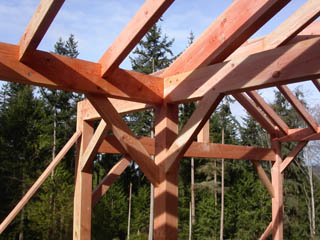Northwest Timber
Frames
Wood
Selection
There
are several species of wood that make excellent timbers for timberframe
construction. Here in the Northwest we normally use Douglas fir
which is readily available and comes in a variety of different
grades, from very tight grained salvaged old growth, to second
and third growth free of heart center. Being located in the Pacific
Northwest puts us very close to some of the best sawmills producing
the finest quality Douglas fir timbers in the world. Other species
can be used, depending on desired cost and appearance, (oak,
pine or cedar for example.) We can also mix species in our timberframes
for a very nice effect.
Another
option is recycled material, which has the advantage of extremely
limited shrinkage as a result of drying that has already occurred
over time. At Northwest Timber Frames we are always looking for
recycled materials and maintain an inventory of such timbers.
Inquire today for availability.
Wood
choice will affect the price of the project. Green, second and
third growth timbers are the least expensive choice for the homeowner
while recycled old growth timbers are the most expensive. If
green timbers are used, there may be substantial shrinkage as
the timbers dry affecting the looks, but not the structural integrity
of the beams. To get the least amount of movement in the timbers
there are several ways to dry the beams. Air drying takes the
longest to get the timbers to a low moisture content. As a general
rule of thumb they will dry 1” per year in thickness, so
a 6 X 12 would take six years on average to naturally dry. The
time required to air dry is often prohibitive for homeowners
looking for minimal shrinkage, however it is the most environmentally
conscious choice using far less energy. A second way to dry timbers
is the use of conventional kilns which basically cook the wood
down to a low percentage. This is how the bulk of standard lumber
is dried. The third way that we can get timbers dried is by RF/V(radio
frequency vacuum kiln). In this technique the timbers can be
dried by using radio frequency, heat and a vacuum pump to speed
the process often drying the timbers in just 4-5 days with minimal
defects in the wood.
|
